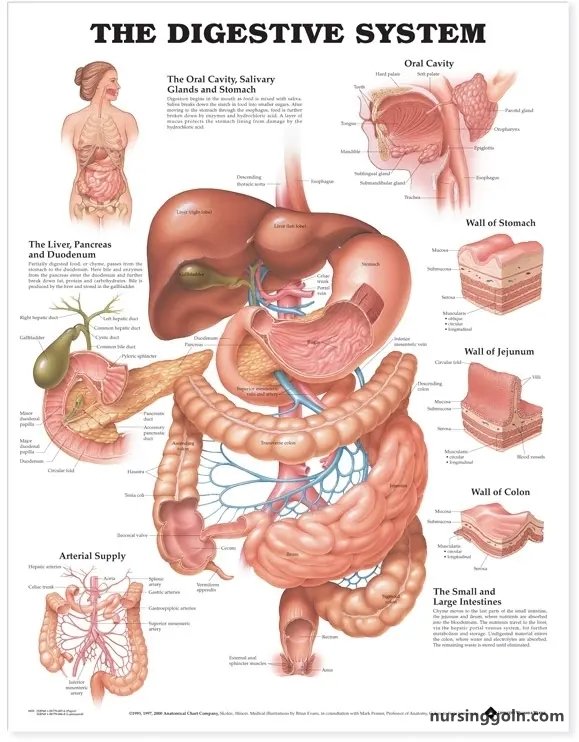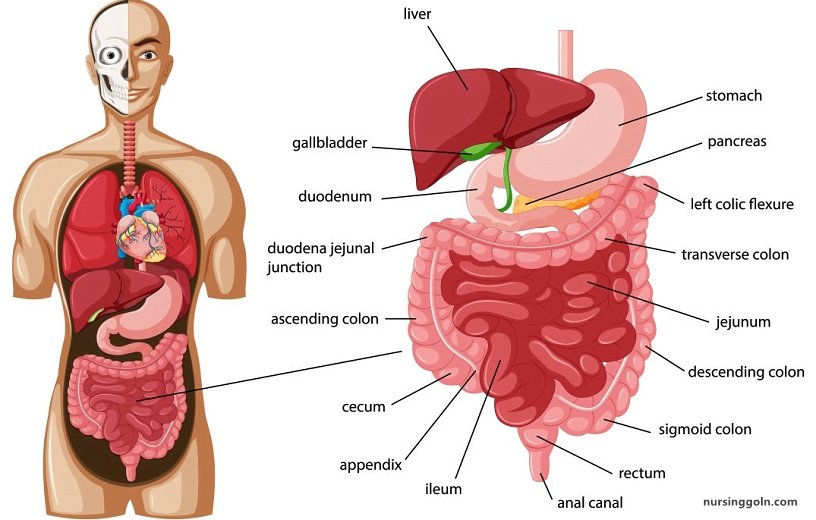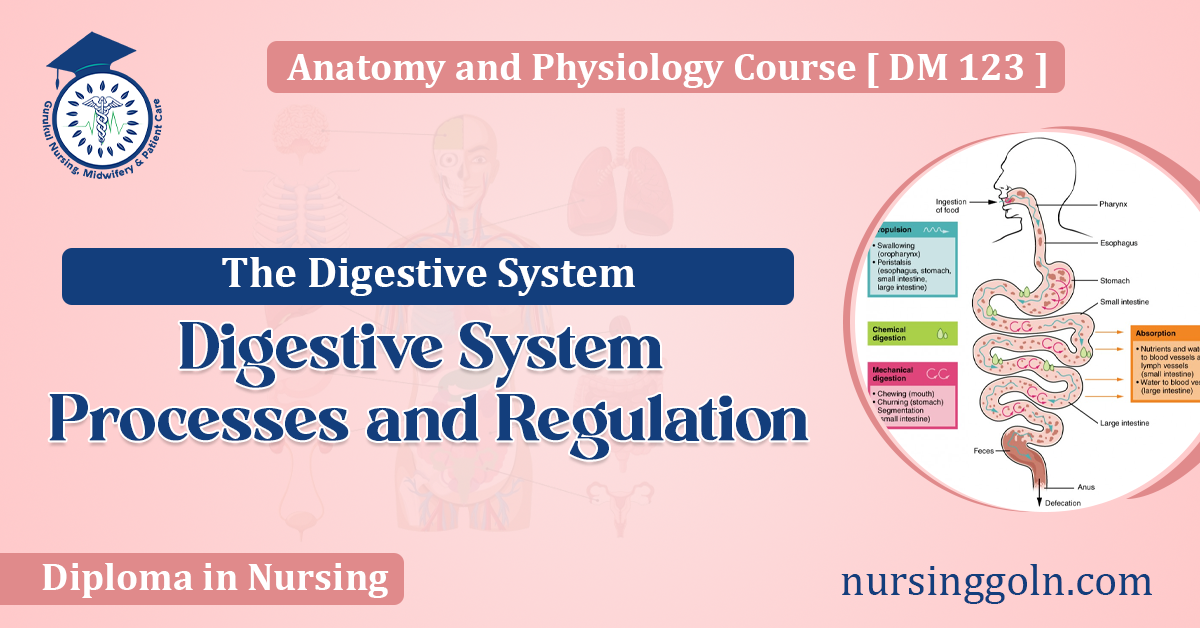Today our topic of discussion is ” Digestive System Processes and Regulation “. The digestive system is a marvel of biological engineering, orchestrating a complex symphony of processes to transform food into nutrients that sustain life.
This intricate dance involves the coordination of multiple organs and systems, all working together to break down complex substances into simpler forms that can be absorbed and utilized by the body. In this article, we will explore the various processes involved in digestion and the regulatory mechanisms that ensure this choreography runs smoothly.
Digestive System Processes and Regulation: The Digestive System

1. Ingestion: The First Act
The process of digestion begins with ingestion, where food is introduced into the mouth. This initial step involves not only the physical act of putting food into the mouth but also sensory and cognitive processes that help regulate the quantity and quality of food intake.
Chewing and Mechanical Digestion
Chewing, or mastication, is the first step in mechanical digestion. It serves several essential functions:
- Reducing food into smaller, more manageable particles.
- Mixing food with saliva to form a semi-liquid mixture called chyme.
- Increasing the surface area of the food, facilitates the action of digestive enzymes.
Saliva and Chemical Digestion
Saliva is secreted by the salivary glands and plays a crucial role in the chemical digestion of carbohydrates. It contains an enzyme called amylase, which breaks down starches into simpler sugars like maltose and dextrin.
2. Deglutition: Swallowing with Precision
Once food has been adequately masticated, the process of deglutition, or swallowing, comes into play. This intricate act involves a sequence of coordinated movements:
- Voluntary phase: The tongue pushes food to the back of the mouth, initiating the swallowing reflex.
- Pharyngeal phase: The epiglottis, a flap-like structure, prevents food from entering the windpipe (trachea), directing it to the esophagus.
- Esophageal phase: Peristaltic waves move food from the esophagus to the stomach.

3. Stomach: The Gastric Ensemble
The stomach is a key player in the digestive system, where the food is temporarily stored and subjected to mechanical and chemical digestion. Here, the coordination of various processes takes place:
Gastric Secretions
The stomach’s inner lining is rich with gastric glands that secrete gastric juice, a highly acidic fluid with a low pH. Gastric juice primarily consists of:
- Hydrochloric acid (HCl): Responsible for maintaining the stomach’s low pH and activating pepsinogen to its active form, pepsin.
- Pepsin: An enzyme that digests proteins by breaking them down into smaller peptide fragments.
- Mucus: Protects the stomach lining from the corrosive effects of HCl.
- Intrinsic factor: Necessary for the absorption of vitamin B12 in the small intestine.
Mechanical Digestion
The stomach’s muscular walls perform a vigorous churning action, mixing food with gastric juice to form a semi-liquid substance called chyme. The contractions also help break down food particles into a more suitable consistency for digestion.
Regulation of Gastric Secretion
Gastric secretion is tightly regulated by neural and hormonal mechanisms. The presence of food in the stomach stimulates stretch receptors, initiating the release of gastrin, a hormone that triggers the production of gastric juice. On the other hand, the presence of acidic chyme in the duodenum can inhibit gastric secretion to prevent over-acidification.

4. Small Intestine: The Star of Nutrient Absorption
The small intestine, a convoluted tube extending from the stomach to the large intestine, is the primary site for nutrient absorption and where most of the digestive processes occur. This section of the digestive system can be divided into three segments:
a. Duodenum: The Chemical Kitchen
- Receiving Bile and Pancreatic Secretions: The first portion of the small intestine, the duodenum, receives digestive secretions from the liver and pancreas. Bile, produced by the liver and stored in the gallbladder, emulsifies fats, breaking them into smaller droplets. The pancreas secretes various digestive enzymes, including amylase (for carbohydrates), lipase (for fats), and proteases (for proteins).
- Regulation of Bile Release: The hormone cholecystokinin (CCK), released in response to the presence of fats in the duodenum, stimulates the gallbladder to contract and release bile.
b. Jejunum: The Absorptive Hall
- Site of Nutrient Absorption: The jejunum is where the majority of nutrient absorption occurs. The inner lining of the small intestine is covered in finger-like projections called villi, which, in turn, have microvilli on their surface. This extensive surface area allows for efficient absorption of nutrients into the bloodstream.
- Absorption of Specific Nutrients: Different parts of the small intestine specialize in the absorption of specific nutrients. For instance, the jejunum is responsible for absorbing amino acids, sugars, and most of the fatty acids.
c. Ileum: The Culminating Finale
The ileum marks the end of the small intestine and plays a vital role in the absorption of vitamin B12 and the reabsorption of bile salts.

5. Large Intestine: The Waterworks
The large intestine is primarily responsible for the absorption of water and electrolytes, the formation of feces, and the transportation of waste material to the rectum. It consists of the cecum, colon, rectum, and anal canal and can be further divided into the ascending colon, transverse colon, descending colon, and sigmoid colon.
Water and Electrolyte Absorption
The large intestine reabsorbs water and electrolytes from the undigested food material, helping to reduce the waste product’s consistency.
Fermentation and Gut Microbiota
The large intestine is home to a complex community of microorganisms collectively known as the gut microbiota. These microorganisms play a vital role in fermenting undigested carbohydrates and fiber, producing gases, and certain vitamins like vitamin K and some B vitamins.

6. Elimination: The Grand Finale
The process of elimination, or defecation, represents the final act of digestion. Once feces have been formed in the large intestine, they are stored in the rectum. When the rectum is full, stretch receptors signal the brain, initiating the urge to defecate. The anal sphincters then relax, allowing the passage of feces through the anus and out of the body.

7. Regulatory Mechanisms of Digestion
The digestive process is highly regulated to ensure that the various steps occur efficiently and that the body’s nutritional needs are met. Several regulatory mechanisms come into play:
a. Nervous System Control
The enteric nervous system, a complex network of neurons embedded in the gastrointestinal tract, regulates many digestive processes. Additionally, the autonomic nervous system, consisting of the sympathetic and parasympathetic branches, influences digestion. The parasympathetic system stimulates digestion, while the sympathetic system inhibits it.
b. Hormonal Regulation
Hormones play a crucial role in the regulation of digestive processes. Key hormones include:
- Gastrin: Stimulates the secretion of gastric juice.
- Cholecystokinin (CCK): Stimulates the release of digestive enzymes and bile, and reduces gastric motility.
- Secretin: Stimulates the pancreas to release bicarbonate to neutralize acidic chyme in the duodenum.
c. Local Factors
Local factors, such as changes in pH and stretching of the stomach and intestines, also influence digestive processes. These factors often work in concert with nervous and hormonal regulation.
8. The Role of Microbiota in Digestion
The gut microbiota, a complex community of microorganisms in the gastrointestinal tract, plays a critical role in digestion. These microorganisms aid in the fermentation of complex carbohydrates, produce gases, and generate certain vitamins. The composition of the gut microbiota can be influenced by factors such as diet, lifestyle, and medical interventions, which, in turn, can affect overall digestive health.

9. Digestive Disorders and Conditions
The digestive system is susceptible to various disorders and conditions that can impact its functioning and health. Some common digestive disorders include:
a. Gastroesophageal Reflux Disease (GERD): Characterized by chronic acid reflux, GERD can lead to esophageal damage and discomfort.
b. Peptic Ulcers: These are open sores that form on the lining of the stomach or the duodenum, often caused by Helicobacter pylori infection.
c. Irritable Bowel Syndrome (IBS): IBS is a chronic condition characterized by abdominal pain, bloating, and changes in bowel habits.
d. Inflammatory Bowel Disease (IBD): This is an umbrella term for chronic inflammatory conditions of the gastrointestinal tract, including Crohn’s disease and ulcerative colitis.
e. Celiac Disease: An autoimmune condition in which the ingestion of gluten triggers an immune response that damages the small intestine.
f. Gallstones: Gallstones are solid particles that form in the gallbladder, often causing pain and discomfort.
g. Pancreatitis: Pancreatitis is inflammation of the pancreas, which can lead to digestive enzyme leakage and tissue damage.
h. Colorectal Cancer: This cancer begins in the colon or rectum and often starts as polyps.
10. Diet and Digestive Health
Diet plays a significant role in digestive health. Consuming a balanced diet rich in fiber, fruits, vegetables, and lean proteins can help support proper digestion and prevent gastrointestinal disorders. Adequate hydration is also crucial for maintaining healthy digestive processes.
11. Future Perspectives in Digestive Health
Advancements in medical science continue to improve the treatment and management of digestive disorders. Innovations in diagnostic tools, minimally invasive surgical techniques, and an increased understanding of the gut microbiota’s influence on health and disease offer promising prospects for personalized approaches to digestive health.

The digestive system is a finely tuned orchestra of processes and regulatory mechanisms, ensuring that the food we consume is broken down, absorbed, and utilized by the body. Understanding the intricate steps involved in digestion and the factors that influence them is essential for maintaining overall health and well-being. As we continue to unravel the mysteries of the digestive system, we gain insights into how diet, lifestyle, and medical interventions can optimize digestive health and contribute to a higher quality of life.
Read more:
